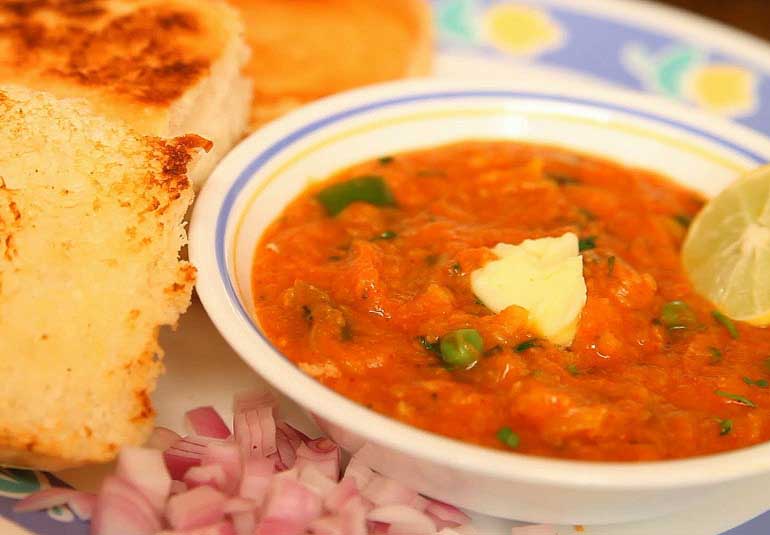Eat like a Textile Mill Worker!
- By Ankita ShreeramLoading...
- | 20 Nov 2017 5:40 PM IST
 X
X

Easy to whip up and even easier to slurp down, steaming hot pav bhaji is a favourite in Indian homes as well as the busy streets of Mumbai. There aren’t too many street foods that can double as wholesome meals but pav bhaji definitely fits the bill. The flaming red “sabzi” gets its colour from tomatoes and sometimes carrots or beetroot, though the base is usually cauliflower and potatoes, along with capsicum and peas. In fact, a variety of vegetables can be sneaked into the preparation and the consumer might never guess! That makes the dish a handy weapon in the repertoire of mothers of picky children as well.

But did you know that this dish which is incomplete without soft, butter-roasted pavs, was originally devised as a quick meal for the textile mill workers of Mumbai? Back in the 1850s, the workers found that they could eat a large plate of pav bhaji in a jiffy, ensuring that their lunch break didn’t keep them away from their chores for too long. Today, the dish is a favourite Sunday meal topped with oodles of butter for those who couldn’t care less about calories.

The “pav” in pav bhaji is the vehicle that helps transport that delicious bhaji into your hungry belly. “Pav” in Marathi actually means “one fourth” and some stories say that pav is called such because it used to come in a set of four. Other accounts attribute its origin to the Portuguese, who managed to woo the Indians with it long before the British arrived with their neat white bread. Pav bhaji used to be considered a lowly food but its popularity in smaller eateries and khau gallis eventually inspired even five star hotels to add it to their menus.
The best pav bhaji
�
While Sardar Pav Bhaji has attained iconic status, there are many other outlets that serve great pav bhaji in Mumbai. Cannon Pav Bhaji opposite CST station is ever-busy, while Bhagwati in Kandivali West is popular among late-night foodies. Maruti Pav Bhaji at Vile Parle and Manohar Pav Bhaji at Girgaum also promise to rustle up delightful versions of the fast food. But to be honest, there’s a juice centre on practically every second street in Mumbai where you can find divine pav bhaji so go find your own favourite!
Variations worth trying

Imagining pav bhaji without potatoes might seem impossible but the Jains have a wonderful version where they swap potatoes for raw banana. Jain pav bhaji doesn’t have onion or garlic either. On the other hand, in Kolhapur, Maharashtra, onion garlic chutney is used in lieu of red chilli powder for added spice and flavour. Masala pav is another offshoot of pav bhaji – essentially the same dish but with the bhaji wedged inside the pav, making it easier to eat. Then there’s kada pav bhaji where you skip the step of mashing up the vegetables, giving you more bite than the conventional version. Cheese pav bhaji is the commonest variant available in almost all restaurants. Chinese pav bhaji, which adds noodles to the pav bhaji mix is not as easily found but you can always make your own.
Recipe for Home-made Pav Bhaji by Seema Gadh:
Ingredients:
2 sticks Butter
3 tbsp Garlic
3-4 Green Chillies
1 1/5 Onions
3-4 Tomatoes
1 1/2 tsp Salt
1 1/2 tsp Red Chilli Powder
4-5 Pureed Tomatoes
4-5 Potatoes
1 bowl Green Peas
Water
1-2 Capsicums
2 tbsp Pav Bhaji Masala
1 tsp Sugar/Tomato Ketchup
1 1/2 Lemon Juice
Coriander
Pav
Method:
Heat a pan and add butter. Do not wait for the butter to heat up and add finely diced garlic. Add diced green chillies, finely diced onion and diced tomatoes and mix it well. Add salt and red chilli powder and let it cook. Keep a little bit of this mix aside for the pav.
Add tomato puree and let it cook. Add mashed boiled potatoes and green peas which has been given one spin in the mixer. Mix it well and pour water. Use the masher to mash the paste. Keep cooking and mashing it. Bring it to a consistency which is neither thin nor thick.
Add finely chopped green capsicum and pav bhaji masala. Add sugar, lemon juice and coriander leaves and stir it. Finally add little butter.
For the pav, take a tawa and add butter to it. Take the pavs and roast them in butter and sprinkle some coriander leaves and red chilli powder. Add the already kept mix and serve it with bhaji.



